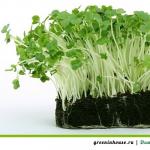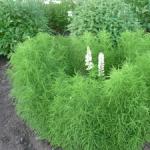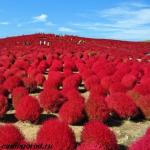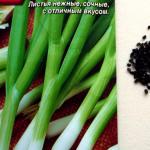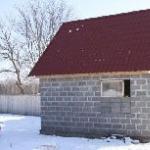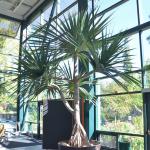This is an ordinary green onion, grown exclusively on a feather, and not on a turnip. Only a small thickening is formed in the soil, called a false bulb, which is also very tasty. You can grow a batun from seedlings and from seeds.
Other names: Tatarka, Pipe bow.
Growing a batun
In Russia, this type of onion is grown throughout the territory, with the exception of perhaps the most northern regions. Batun is a perennial onion that can grow in one place for up to 10 years, but it is most productive for the first 3-4 years.
Growing a batun is not a difficult task - even a beginner who has never grown onions can handle it.
This onion is suitable for growing in a heated greenhouse for greenery in winter. What does it grow even at a temperature of +12-+13 degrees, which is very convenient (energy consumption is not as large as when growing an ordinary turnip for greens).
Onion batun is frost-resistant, endures even harsh winters with air temperatures down to -40 degrees. In the spring, as soon as the soil thaws, green onion sprouts immediately appear, and it will withstand return frosts down to -6 degrees stoically. This is the first spring greens on our tables.
Onion batun from seeds

When to sow onions. The seeds of onion batun are sown as soon as the earth “moves away” from the frost, that is, as soon as the snow melts and the top layer of soil melts. In many regions, planting can be done as early as March. In the middle lane, sowing is recommended in the month of April.
Planting is carried out both with dry seeds and germinated. Soaking is carried out in ordinary water separated from chlorine, on a wet cloth, gauze, etc., until single pecking. Often the seeds are prepared for sowing by bubbling for 12-18 hours.
Then the seeds are slightly dried to flowability and sown in open ground or under a film.
Onion greens are ready for the first cut, when their length is 20-25 cm. At this time, the feather is its most delicious - tender, juicy, it contains a huge amount of vitamins, which undoubtedly indicates its usefulness. It contains carotene, sugar, ascorbic and nicotinic acid, thiamine, riboflavin, salts of potassium, magnesium, iron.
Batun leaves are cut at ground level, tied into neat bundles and stored in a refrigerator in plastic bags or film.
Over time, flower stalks will appear on the onion, while the growth of the leaves slows down and then completely stops, they coarsen and the quality of the product decreases accordingly. After a certain time, seeds will ripen on these peduncles (with early spring planting, approximately at the end of July), collect them, and then remove both peduncles and old leaves.
At this time, the batun begins a period of rest, which lasts 1.5-2 months. Further, it is desirable to feed the onion with a full complex mineral fertilizer, loosen the aisles and water. After about 2 weeks, the batun will give new young greens (September-early October).
You can sow this onion in the summer, up to the month of August.
Onion batun seedlings

In principle, you can grow this onion through seedlings. Basically, this is how gardeners grow in the northern regions and the middle zone, where the summer is short and sowing onions in open ground is possible only in late May and early June. And if you want to have greenery at the beginning of summer, then plant batun onions for seedlings in mid-late March.
You can also sow dry or soaked seeds. The soil for planting onions should not be heavy, it must contain river sand (and preferably vermiculite), they make the soil loose.
Seeds are planted to a depth of 1.5 cm, about 2-2.5 cm are left between plants.
Onion batun on the windowsill
To grow this onion at home, dig up a few plants and plant them in a box along with a clod of earth. Place the crate on the sunniest window sill. If the window sill is concrete (cold), then be sure to make a gasket between the box and the window sill so that the onion roots are not cold, otherwise they will rot. Naturally, the onion will grow better if additional lighting is installed above the plantings.
The best varieties of onion batun: description, photo, characteristics
We give a description of only 5 varieties of this onion, which received only positive feedback from gardeners. For these reasons, they are the most popular and in demand.

Onion batun April
Early ripe salad variety. The leaves are bright green, tender, juicy, do not coarsen for a long time, semi-sharp taste. The average weight of 1 plant is up to 300 g. The variety is frost-resistant, not prone to diseases. Grown in annual and perennial crops.
Seeds are sown in early spring (as soon as the soil allows) to a depth of 0.5-1.5 cm, with a distance between plants of 20 cm. Over the summer, 3-4 cuttings of green feathers are carried out. April onions can be grown in one place for up to 5 years.
Seeds of onion-batun varieties April firms Plasma seeds.

Onion batun Russian winter
The value of the variety: high yield, excellent taste, long-term return of marketable green onions, high winter hardiness.
Mid-season (27-30 days period from the beginning of leaf regrowth to technical ripeness) variety of perennial onion batun. The taste is semi-sharp. The variety is not affected by diseases. yield greenery per cut 1.58 kg/sq.m., per season 3.68 kg/sq.m.
Propagated by seeds and division of the bush. During the summer, it is recommended to carry out 2-3 cuts of green leaves. With an annual crop, early spring sowing and one-time harvesting of plants at the end of the season (together with a false bulb) are carried out. The leaves do not coarsen for a long time when harvested with the bulb. In one place, this onion grows well up to 5 years.

Bow batun Tenderness
Mid-season, winter-hardy, lettuce onion variety. The period from the beginning of the growth of leaves to economic suitability is 30 days. Leaves up to 35 cm long, green, with a slight wax coating, juicy, not coarsening for a long time, with a delicate, slightly spicy taste. The variety is valued for its high yield, early production of green products, high winter hardiness, high content of vitamin C, carotene, vitamins B1, B2 in the leaves.
It has a disinfectant, diaphoretic, hemostatic action. Recommended for hypertension, atherosclerosis, dysentery, gout. Excellent honey plant. Ideal for eating fresh, preparing salads, decorating dishes.

Bow batun Russian size
Grown as an annual crop. It has an incredibly wide tubular feather (up to 5 cm in diameter) with a mild sweetish taste. It can grow to the size of a leek. Feather length - up to 70 cm! Suitable for stuffing and cooking savory dishes.
Sowing for seedlings is carried out from mid-February, the depth of seed placement is 1-2 cm. Planting in the ground is recommended in the second half of May.
Top dressing 1 time in two weeks during the entire growing season. Care consists in systematic weeding, loosening, fertilizing and watering.

Bow batun Long Tokyo
An early ripe variety of perennial onions, suitable for obtaining early vitamin greens in all regions of Russia in open ground from spring to late autumn.
The plant is tall. The leaves are fistulate, erect, dark green, with a slight waxy coating, up to 60 cm long. The leaves are tender, pungent in taste, but less spicy compared to onion greens.
This bow is frost-resistant, withstands temperatures down to -25 degrees without snow cover. Traditionally grown as a perennial crop. A more progressive method is an annual crop of greens, with sowing at the end of April and in July. The July sowing is not completely harvested, it is advisable to leave some of the plants in the winter to obtain products in April. With a perennial crop, the leaves are cut off, with an annual crop, the whole plant is removed.
yield for one-time cleaning 4 kg/sq.m.
How to grow onion batun, video
If you grow onion batun, please write which varieties do you like best? If possible, attach a photo of the batun onion you have grown. Thank you.
Your reviews of the onion batun will help many gardeners choose the best seeds for planting.
For the sake of getting greenery, gardeners and gardeners grow onion batun both as an annual and as a perennial plant.
In plots and dachas, it is most often propagated by seeds, since there is no shortage of them, and it gives a lot of them. It is also possible to reproduce the batun vegetatively, that is, by dividing the bush.
Planting onion-batun:
There is nothing difficult in planting a batun, sow the seeds in early spring or summer (but no later than the first half of August).
If you sow onions in early spring, then the seeds are sown even in February windows. In this case, you will receive the harvest (green leaves of batun) in July-August.
If you plan to get green leaves from these plantings for the next spring (early green), then cut the last leaves no later than mid-August. After the cut, be sure to water, fertilize (fertilize) and loosen the bed with onions with a batun so that it has time to gain energy and nutrients before the start of winter and give them to greenery in the spring when forcing.
During vegetative propagation, perennial batun bushes are divided into parts, on average, three to five plants per turf, and planted in the soil. To obtain an early harvest in spring, it is advisable to transplant seedlings before mid-August.
Batun onion is also good because its forcing into greens can be successfully done in early spring, right in the open field, under tunnel film greenhouses-shelters.
This method of forcing an early batun will allow you to get a crop two or even three weeks earlier (mid-March) than from open ground.
When sowing seeds in early spring (in March), calibrated dry seeds can be used, and when re-sowing in summer, the seeds must be prepared. To do this, soaking in water is carried out, and then germination until a single pecking, and even better bubbling for 13-18 hours.
Then the seeds are dried to flowability and sown.
The recommended landing distance (manual) is 30 to 40 centimeters. The depth of seed placement during sowing is 1.7-2 centimeters. With such a scheme for planting a batun, approximately 2.5-3 grams of seed per 1m 2 is consumed.
Harvesting onions
There are two ways to clean the batun.
If cultivation of onion batun is produced as an annual, then the seeds are sown in the spring, and the crop is harvested (the whole plant) the following spring, in March-April. But on heavy soils, digging is associated with great difficulties, since the soil is waterlogged, sticks to the roots and the “bulb”, and when washing, the leaves burst and break, the commercial qualities of onion greens are lost.
If grow onion batun as a perennial then they usually spend one or two cuttings of leaves in spring and the same amount in autumn.
Batun greens are cut when its leaves become 20 to 25 centimeters long. At the first cut in spring, the leaves are the most tender, juicy, contain many vitamins, especially vitamin C - up to 56 - 92 mg%, as well as vitamins A, B 1, B 2, PP and biologically active substances. In addition, the leaves of the onion-batun contain salts of magnesium, potassium, iron.
Batun leaves should be cut at ground level and tied into bundles, cooled and stored in a refrigerator in a plastic bag. They are clean and do not need to be washed.
With the appearance of flower stalks ( photo bow batuna 2) on the plant, the growth of the leaves slows down and then stops completely, they become coarser, the quality of the product decreases.
After you have prepared the seeds (approximately at the end of July), remove the old leaves and flower stalks.
At this time, the batun begins a period of rest, which lasts 1.5-2 months. Then the plants are fed with a full complex mineral fertilizer, the aisles are loosened and watered.
After a couple of weeks, the plants will begin to grow and give young greens in September, maximum October.
 Paisley Wooden Bow Tie Handkerchief Set Men's; checkered…
Paisley Wooden Bow Tie Handkerchief Set Men's; checkered…
575.54 rub.
Free shipping★★ ★★ ★★ ★★ ★★ (4.90) | Orders (146)
Onion batun is not a frequent guest in my beds, but I think it's worth talking about it. Think few plant it though get knowledge how to grow onion batun will be helpful. Moreover, it is worth planting this type of onion, if only because of its taste and ease in agricultural technology. In principle, in visual comparison, it is similar to ordinary green onions and onions, but it still has several differences. It does not form a bulb, like onions, and the greens are coarser than those of the same multi-celled onion. But there is a similarity that develops into an advantage. Onion batun easily tolerates low and high temperatures, like many types of onion varieties. In this note, I will tell you in detail how to properly plant, about growing and caring for the type of onion batun. So, let's begin …
Where do onion roots grow from?
Despite the fact that onion batun is rarely grown, it is popular with true connoisseurs of green onions. It is quite possible that you have heard how some gardeners talk about Chinese onions and onions. So we are talking about the same bow - a batun. In the common people, it is called so because of its history of origin. Onion batun has been grown for many centuries in the Asian territory of China and Japan. On the same territory, including the territory of Siberia, one can still observe wild plantings of batun, which multiplied according to the principle of self-sowing. The fact is that this type of onion is rightfully considered perennial. If you constantly take care of the onion batun, then it gives good yields. If abandoned, it will reproduce on its own and begin to run wild. Which will lead to a significant decrease in yield and loss of presentation.
Unlike amateur gardeners, the cultivation of batun onions is popular with farmers. They grow it in greenhouses for further sale. That is to say, for commercial purposes. Onion batun produces little to no bulb, and when grown for sale as chives, the slight bulb gives extra weight.
The batun onion bulb itself is more like and tolerates severe frosts in the ground. But the surface green part favorably tolerates only light frosts. The batun onion vegetation process begins very early in the spring, as soon as the temperature starts to rise slightly above zero.
Useful video about onion batun, watch to the end!
Growing onion batun
Growing onion batun can be done in several ways. Like many varieties of onions, it can be grown through sowing seeds in open ground and through seedlings. Seedlings are sown in the greenhouse in early January. If the goal is to get an early harvest, then the cultivation of batun is definitely worth doing through seedlings.
But if there is no rush in terms or there are no conditions for growing seedlings, it is sown with seeds. Batun onion seeds should be sown in open ground as soon as the weather and soil structure make it possible to plant. In the event that the onion is planted with seeds, then the maximum yield will come only after a couple of years.
Preparing batun onion seeds for planting
Preparing batun onion seeds for planting is a rather dreary business. I recommend sowing them immediately in open ground and producing as needed. Just pre-soak for half an hour in warm water with the addition of potassium permanganate. The potassium permanganate solution should be light pink. Thanks to this action, the seeds will pass the stage of disinfection. Why do I recommend planting a batun in this way? The fact is that any onion seeds germinate for a very long time. Sometimes this process takes a whole month. And the most you lose is an extra week. It is just for one week that you can accelerate the germination of seeds if you resort to dreary preparation.
But if you need to speed up the germination of the "black" batun, then get ready to tinker. In the process of preparation, time intervals will have to be observed. First, as I said, the seeds are soaked for half an hour in warm water with potassium permanganate. After that, all seeds need to be washed clean. filtered water or the water must be settled in advance. Then we resort to the old proven method for soaking seeds - gauze. Gauze is folded into at least five layers and batun seeds are wrapped in it. Gauze with onion seeds is placed in a container with warm water at room temperature, but not more than 30 degrees. The whole process takes a day. Three times a day, with the same time interval, the water changes. It is imperative to do this. After a day, the water is drained, the gauze is squeezed out and the seeds need to be dried well. Batun onion seeds should regain their original crumbly appearance. only after such a procedure, it is possible to sow seeds in open ground and they will germinate a week earlier.

Photo: Growing onion batun from seeds in the open field
How to grow onion batun seedlings
To obtain an early harvest of batun onions, it is planted through seedlings. Seeds for seedlings are planted in early January in a greenhouse and in July you can start harvesting. Resorting to such agricultural technology, the batun is not considered as a perennial plant and the crop is harvested completely with the bulb. Just like they do with the usual.
Before sowing seeds for seedlings, you need to prepare the substrate. In principle, its composition is no different from that required for growing seedlings of other crops. To do this, you must use: 50% ordinary soil, 30% humus or compost, 10% overripe sawdust or hydroperlite, 10% sand. There is no point in adding any chemical fertilizers. First, all the main nutrients are in the humus or compost. Secondly, when growing seedlings, onions use seed reserves and practically do not use top dressing from the substrate.
After the substrate is prepared, you need to sow the seeds of the batun. Pre-prepare the seeds in one of the above ways. The container in which the cultivation of seedlings of onion batun will proceed should have holes at the bottom to quickly remove excess water after watering. I recommend growing seedlings not in cups and pots, but in long tubs. Pre-prepared soil is poured into the container and watered. After a couple of hours, when the soil picks up moisture and excess water drains, grooves are made with a pencil. The depth of the grooves should be no more than three centimeters. Onion seeds are sown in grooves and sprinkled with humus or sawdust. After the seeds are sown and covered, the grooves are lightly rammed. This is done to better contact the seeds with moist soil.
Growing seedlings of onion batun
Growing seedlings of onion batun should proceed at a temperature of +6 - +12. Too high a temperature is harmful. At high temperatures, the seeds will germinate faster, and the seedlings will also grow faster, but the quality will be unsatisfactory. In order not to resort to additional illumination of seedlings and further hardening, seedlings should grow at a temperature not higher than +12. Then exactly by April, it will be powerful and will quickly take over after transplanting into open ground. Under certain conditions, the container must stand for the entire time. As soon as the seeds germinate and straighten to the form of "needles", it is necessary to thin out the grooves, leaving a distance of 1-2 cm between the "needles". Watering is not often necessary, only as needed.
Planting seedlings of onion batun is carried out in April, when the weather and soil allow the cultivation of a vegetable garden. The distance between seedlings is 10-15 cm, the row spacing is 40-50 cm. Two-line planting of seedlings can be used. After planting seedlings of batun, the beds are carefully watered. A few days after planting, the seedlings will take root and straighten up. so you don’t need to worry if, after a couple of hours after planting, all the seedlings died. This is a common occurrence.
Preparing the site for planting batun onions
Some gardeners in vain consider this culture capricious. Batun gives good results, provided that the preparation of the site for planting batun onions is done correctly. For fruitful cultivation, fertile soil is needed, which contains balanced nutrients. It is also worth paying attention that this plant reacts poorly to acidic soils. Before planting a batun onion, lime or dolomite flour must be added to the soil. Nitrogen, magnesium, phosphorus and potassium are introduced into the soil as nutrients. After all the components are introduced into the soil, the soil is dug up or milled.
In the process of preparing the soil for onion batun, which is planned to be grown for several years in a row, special attention is paid to soil aeration. The ground in open ground should be well structured and crumbly. This quality of the substrate prevents waterlogging of the soil during the watering of the batun - which he loves so much. A crumbly soil structure can be achieved by introducing horse manure or overripe softwood sawdust. Remember one rule - "a batun onion loves a chopper." In the process of growing batun onions, the beds constantly need to be loosened. Loosening the soil is done every two or three waterings.
Despite the fact that proper soil preparation has been carried out, during the growing season, batun onions take nutrients from the soil and must be fed with nitrogen and potassium fertilizers. In winter, onion batun must be sent fertilized. To do this, manure and phosphate fertilizers are introduced into the aisles, after which everything is dug up. That manure, that phosphate fertilizers will give nutrients to the soil during the winter, and in spring the onion batun will receive high-quality top dressing.
Planting onion seeds batun
It is worth noting that planting onion seeds is universal in terms of sowing. Winter is the only exception. And so, batun seeds can be sown at any time of the year and in any month. Of course, if you are sure that you can, for example, in July, in case of intense heat, provide planting with constant watering. If not, then the seeds simply will not hatch and will be steamed under the crust of the soil. The optimal and simpler time for planting batun onion seeds is traditionally spring or autumn. What is in the first, what is in the second option, the soil is saturated with moisture and the seeds germinate well and quickly.
Planting seeds of onion batun is carried out in shallow grooves, like any onion seeds that are grown on a feather. Usually the depth of the furrow is 1.5-3 cm. Before planting batun seeds, if you do not use precision seeders, but are going to sow manually, I recommend mixing the seeds with sand 1: 1. This will allow you to sow the seeds more evenly and less densely. upon completion of sowing, I advise you to sprinkle the seeds with peat, humus or sawdust. Then water abundantly. After thorough watering, the upper substrate will be saturated with moisture, the onion seeds of the batun will quickly hatch and sprout.
Do not ignore the width of the beds. It should be at least 35 cm, which will allow you to easily take care of the batun and there will be a sufficient aisle, which is dug up in the winter. Further, when the seeds have sprouted and the formation of the first true leaves has begun, the beds are thinned out. A distance of 3-5 cm is left between each plant. While the onion batun is gaining strength, it requires care in the form of constant watering. If the seeds were planted towards the end of spring, watering is done in the morning and evening daily. But! - waterlogging of the soil is not allowed.
Diseases and pests in the cultivation of onion batun
Batun, like other types of onions, is susceptible to disease or pest attacks. Do not neglect the rules of agricultural technology during the growing season. The beds must be kept free of weeds at all times. Monitor the aeration of the soil, constantly loosen the upper crust and prevent waterlogging during irrigation. And in general, always do the right thing. If you start landing, they will definitely be hit. The main and common enemies are: from diseases - fungal infections; of the pests - the onion fly. To prevent fungal diseases, the beds are periodically watered with phytosporin. It also helps to get rid of onion fly larvae. How to deal with this pest, you can read a note about.
Harvesting onion batun
Well, I got to the most pleasant moment - harvesting the batun onion. Onion batun grows on average half a year. If it was planted in early spring, then in the middle of autumn you can remove the batun. But if the planting of the batun onion was carried out at the beginning of summer, then it will be possible to harvest the crop only next spring. Therefore, before planting onions, think about the harvest time.
Harvesting consists in cutting young leaves of batun. As a rule, leaves are cut from the bottom up, with a well-sharpened tool. The cut must be made at the base of the leaf without damaging the stem. In order for the leaves of the onion of the batun to be elastic and juicy, before harvesting, the onion is watered in the evening. overnight, all the leaves will gain moisture at a lower night temperature and will be "fleshy".
Here I am sharing with you how to grow onion batun from seed outdoors how to care for and harvest a good harvest. I hope the note was useful to you, write comments and share on social networks.
Have a good harvest of batun onions!
After winter beriberi, you can easily replenish vitamins from a young onion feather if you plant a batun before winter. Opinions about the homeland of the plant differ. Some experts believe that it was grown in China, others - in Asia. In its natural environment, it grows in Japan, Siberia and Asian countries. Tatarka and piped onions are also common names for this type of onion. The plant is cultivated all over the world because of a very delicate taste, not typical of other varieties, and for early germination.
Is it possible to sow onions before winter
This onion variety is frost-resistant, it can be planted before winter. It belongs to those vegetable crops that, when sown in late autumn, grow stronger than when planted in spring. Like every perennial crop, onions need to be stratified for good germination.
Not all varieties of crops are suitable for winter planting, but only those that can endure even a snowless winter. These varieties include:
- April;
- May;
- Salad-35.
In one place, onions are grown for several years. If you plant it in the last month of autumn, then in March you can already enjoy the sweet, fragrant feathers of a vitamin plant.
When to plant onion seeds
Sowing onion-batun can be done at least three times a year, but its seeds lose their ability to germinate during storage, so sowing before winter for this plant is the best option.

It can also be planted in any spring-summer month and get a good harvest of vitamin greens. For earlier shoots, planting is organized in February, the last sowing date should be no later than July-August.
Basically, seeds are planted onion trampolines for seedlings - this is the most reliable way to get early greens. In this case, sowing begins in February, planted in open ground, depending on the climatic conditions of the region.
Planting onion-batun with seeds before winter begins in the last autumn month.
When to plant onions before winter
When planting a batun before winter, it should be borne in mind that early varieties sprout quickly, but their feathers also quickly become coarse, fibrous and unsuitable for food.
Late varieties are high yielding, they produce fresh, juicy stems within 5 months.

Planting onion-batun in the fall before winter begins no earlier than November, when the top layer of the earth survives the first frosts. The air temperature should be at least 5-6 degrees.
Landing site selection
Such a culture does not like direct exposure to the sun; a shaded place is more suitable for it. The plant is well poured with juice under the cover of trees or hedges.
A rich harvest of onion-batun will be on the soil where the predecessors were:
- legumes;
- cabbage;
- tomatoes.
Planting after such crops is undesirable:
- onion;
- garlic;
- carrot.
The most suitable for planting onion-batun lands in the lowlands, where there are no shallow deposits of underwater water. It is not recommended to plant on slopes and hillocks, so that during precipitation the soil is not washed away with water.
Land preparation
The land is disinfected and fertilized with organic fertilizers a month before planting.
A good harvest directly depends on the composition of the soil. She must be:
- loamy, sandy;
- subacid;
- fertile, fertile;
- with moderate humidity.
The drying of the earth must not be allowed - on the dried ground, arrows are intensively formed in the bow.

If the earth is highly acidic, it must be neutralized. To do this, six months before sowing, they add to it:
- wood ash;
- lime;
- dolomite flour.
Since the culture will grow in one place for several years, it is necessary to fertilize the land well in advance. Into the soil for 2-3 months before planting make:
- humus;
- mineral and organic fertilizers;
- ammonium nitrate.
The earth should be well saturated with fertilizers; after sowing, the soil is no longer nourished so intensively.
Seed preparation
Onion seeds need to be calibrated. To do this, they are kept in a 1:10 saline solution for half an hour. In this case, poor-quality seeds float to the surface.

Seeds that have settled to the bottom are treated as follows:
- Washed.
- Soak for disinfection in a solution of manganese for 20-30 minutes.
- Withstand 7-8 hours in a solution of a growth stimulator.
When updating the beds, the collected seeds can be dried, processed and left for the next sowing.
Sowing onion-batun before winter
When planting, a large number of seeds are sown, taking into account the fact that some of them may not sprout.

- the best time for planting a Tatar is after the first slight frost, at the end of November;
- for planting choose loamy soil;
- before sowing, the land is fertilized - superphosphate, humus, potassium salts are added;
- loosen the earth, remove weeds;
- the interval between the grooves should be 20-22 cm;
- landing hole - 2 cm deep, between the holes you need a space of up to 4 cm.
After planting onion-batun, the site is mulched with fallen leaves, vegetable tops or peat.
When planting vegetatively, a perennial bush should be divided into parts. The batun does not have bulbs, as in an ordinary onion, and the stems are collected in bunches with a thickening downwards. At the end of each of them should be a thin spine.
In severe frosts, it is necessary to insulate the garden bed, for this it is covered with polyethylene, securing along the edges from gusts of wind.
In early spring, it is also necessary to cover the first onion sprouts with foil so that they do not get damaged.
Care after landing
Batun onion is a moisture-loving culture, so the earth should be regularly moistened.
As soon as the first feathers appear, onions must be:
- thin out the plant;
- treat with a growth stimulator;
- regularly, especially after rains, weed and loosen the soil;
- water moderately every other day;
- cut off the feathers of the onion as soon as they grow more than 15 cm.

Since this is a perennial crop, it is necessary to remove old plants every year and plant new ones. Renewal is necessary to increase productivity.
Despite the fact that the Tatar retains productivity for 10 years, it is recommended to renew the beds every 5 years.
The first year after planting, the onion does not require intensive feeding, it can only be lightly sprinkled with ash.
Advice! In the first year, it is not recommended to cut the leaves of the onion-batun, this will help it to overwinter the first winter well and get stronger.

Conclusion
Planting a batun before winter is not difficult at all, this action is available to every gardener. Before planting, it is necessary to decide on the choice of variety, to study its characteristics. The first feathers of green onions will begin to break out from under the snow, if planted correctly in the spring.
With a little effort, you can get early, juicy greens with a large complex of vitamins and microelements on the table.
Similar posts
There are no related posts.



